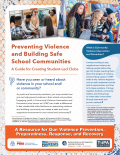
Physical safety refers to the protection of all stakeholders, including families, caregivers, students, school staff, and the community, from violence, theft, and exposure to weapons and threats, to establish a secure learning environment.
For students to learn, they need to feel safe. It is essential that all students be able to attend schools that provide a safe environment where they can thrive and fully engage in their studies without the distraction and worry about physical safety concerns.
Physical safety is related to higher academic performance, fewer risky behaviors, and lower dropout rates.
Students who feel safe are more likely to stay in school and achieve academically.
Students who are not fearful or worried about their safety feel more connected to their school and care more about their educational experience.
Boccanfuso, B., & Kuhfeld, M. (2011). Multiple responses, promising results: Evidence-based, nonpunitive alternatives to zero tolerance. Washington, DC: Child Trends.
Davis, J. E., & Jordan, W. T. (1994). The effects of school context, structure, and experiences on African American males in middle and high school. Journal of Negro Education, 63, 570-587.
Furlong, M. J., Whipple, A. D., St. Jean, G., Simental, J., Soliz, A., & Punthuna, S. (2003). Multiple contexts of school engagement: Moving toward a unifying framework for educational research and practice. The California School Psychologist, 8, 99-114.
DeVoe, J., & Murphy, C. (2011). Student Reports of Bullying and Cyber-Bullying: Results From the 2009 School Crime Supplement to the National Crime Victimization Survey (No. NCES 2011-336). Washington, DC: National Center for Education Statistics, Institute of Education Sciences, U.S. Department of Education.
Fekkes, M., Pijpers, F. I. M., & Verloove-Vanhorick, S. P. (2006). Effects of Antibullying School Program on Bullying and Health Complaints. Archives of Pediatrics & Adolescent Medicine, 160(638-644).
Glew, G. M., Fan, M.-Y., Katon, W., Rivara, F. P., & Kernic, M. A. (2005). Bullying, Psychosocial Adjustment, and Academic Performance in Elementary School. Archives of Pediatrics & Adolescent Medicine, 159, 1026-1031.
Gottfredson, G., & Gottfredson, D. (2001). What schools do to prevent problem behavior and promote safe environments. Journal of Educational and Psychological Consultation, 12(4), 313-344.
Harper, K. (2010). Measuring School Climate. Paper presented at the Safe and Supportive Schools Grantee Meeting, Washington, DC.
Johnson, D. W., Hinze-Pifer, R., Orta, D., & Guz, S. (2024). Mitigating the academic impacts of proximity to homicide. Retrieved from https://consortium.uchicago.edu/publications/mitigating-the-academic-impacts-of-proximity-to-homicide
Mayer, G. R. (2001). Antisocial behavior: Its causes and prevention within our schools. Education and Treatment of Children, 24, 414-429.
Nansel, T. R., Overpeck, M., Pilla, R. S., Ruan, W. J., Simons-Morton, B., & Scheidt, P. (2001). Bullying behaviors among US youth: prevalence and association with psychosocial adjustment. Journal of the American Medical Association, 285(16), 2094-2100.
Neild, R. C., Furstenberg Jr., F. F., & Stoner-Eby, S. (2002). Connecting Entrance and Departure: The Transition to Ninth Grade and High School Dropout. Unpublished.
Osher, D., & Kendziora, K. (2010). Building Conditions for Learning and Healthy Adolescent Development: Strategic Approaches. In B. Doll, W. Pfohl & J. Yoon (Eds.), Handbook of Youth Prevention Science. New York: Routledge
Osher, D., Sprague, J., Weissberg, R. P., Axelrod, J., Keenan, S., Kendziora, K., et al. (2008). A comprehensive approach to promoting social, emotional, and academic growth in contemporary schools. In A. Thomas & J. Grimes (Eds.), Best practices in school psychology V (Vol. 4, pp. 1263–1278). Bethesda, MD: National Association of School Psychologists.
Osher, D., Dwyer, K., & Jimerson, S. R. (2006). Safe, supportive, and effective schools. In S. R. Jimerson & M. J. Furlong (Eds.), Handbook of school violence and school safety: From research to practice (pp. 51-72). Mahwah, NJ: Erlbaum.
Ripski, M. B., & Gregory, A. (2009). Unfair, unsafe, and unwelcome: Do high school students' perceptions of unfairness, hostility, and victimization in school predict engagement and achievement?. Journal of School Violence, 8(4), 355-375
Scales, P. C., & Roehlkepartain, E. C. (2004). Service to others: A gateway asset for school success and healthy development. In National Youth Leadership Council, Growing to greatness: The State of Service-Learning Project (pp. 26-32). St. Paul, MN: National Youth Leadership Council.
Skiba, R., & Rausch, M. K. (2004). The Relationship between Achievement, Discipline, and Race: An Analysis of Factors Predicting ISTEP Scores. Bloomington, IN: Center for Evaluation and Education Policy.
Steinberg, M. P., Allensworth, E., & Johnson, D. W. (2011). Student and Teacher Safety in Chicago Public Schools: The Roles of Community Context and School Social Organization. Chicago: Consortium on Chicago School Research.
Cohen, J. (2021). School safety and violence: Research and clinical understandings, trends, and improvement strategies. International journal of applied psychoanalytic studies, 18(3), 252-263.
Croft, M., Moore, R., & Guffy, G. (2019). Creating Safe Schools: Examining Student Perceptions of Their Physical Safety at School. Insights in Education and Work. ACT, Inc.
The Annie E. Casey Foundation. (2021, August 30). Creating a sense of belonging. The Annie E. Casey Foundation. Retrieved from https://www.aecf.org/blog/creating-a-sense-of-belonging
Ancess, J., Rogers, B., Duncan Grand, D., & DarlingHammond, L. (2019). Teaching the way students learn best: Lessons from Bronxdale High School. Palo Alto, CA: Learning Policy Institute.
